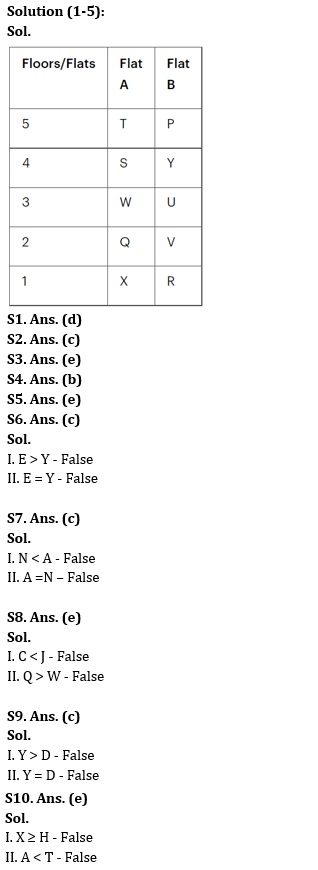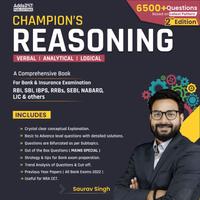Directions (1-5): Answer the following questions based on the information given below.
There are two types of flats i.e., flat A and flat B on each floor of a five- floor building. The bottommost floor is numbered as 1, just above it is numbered as 2 and so on till the topmost floor is numbered as 5. Flat A is in west of Flat B. Ten persons (P, Q, R, S, T, U, V, W, X, and Y) live in these flats such that one person lives in each flat but not necessarily in the same order.
Note: If a person lives in a flat adjacent to another person, then both persons live on the same floor. If a person lives two/three floors above/below another person, then both persons live in the same type of flat unless stated otherwise.
Q doesn’t live in Flat B. U lives immediately above V. P lives two floors above W but not in the same type of flat. Y lives adjacent to S but not in the same type of flat as W. Both U and V live on a prime numbered floor. W lives two floors above X. Neither U nor V lives adjacent to X. Neither Q nor R lives above S. V doesn’t live adjacent to R.
Q1. T lives on which of the following floor?
(a) 4th floor
(b) 3rd floor
(c) 1st floor
(d) Same floor as P
(e) None of these
Q2. R lives on ______________floor below Y.
(a) One
(b) Two
(c) Three
(d) Four
(e) None of these
Q3. Who among the following person doesn’t live in Flat B?
(a) P
(b) V
(c) Y
(d) U
(e) T
Q4. Who among the following person lives adjacent to Q?
(a) P
(b) V
(c) R
(d) X
(e) T
Q5. Four of the following five are alike in a certain way and hence form a group. Who among the following doesn’t belong to that group?
(a) P
(b) V
(c) Y
(d) R
(e) S
Directions (6-8): In the following questions assuming the given statement to be true, find which of the given conclusion(s) is/are definitely true and then give your answers accordingly.
Q6. Statements:
P < Y = Z ≤ E= V, E ≤ U = F ≥ D, U > I = S > X
Conclusions:
I. E > Y
II. E = Y
(a) Only conclusion I is true
(b) Only conclusion II is true
(c) Either conclusion I or II is true
(d) Both conclusions I and II are true
(e) Neither conclusion I nor II is true
Q7. Statements:
Y > C > G = D > A, J ≤ A = X ≥ Q, X ≥ T = N > S
Conclusions:
I. N < A
II. A =N
(a) Only conclusion I is true
(b) Only conclusion II is true
(c) Either conclusion I or II is true
(d) Both conclusions I and II are true
(e) Neither conclusion I nor II is true
Q8. Statements:
R > Z ≥ X < W, C > Q ≥ O = R, J < L = Q < P
Conclusions:
I. C < J
II. Q > W
(a) Only conclusion I is true
(b) Only conclusion II is true
(c) Either conclusion I or II is true
(d) Both conclusions I and II are true
(e) Neither conclusion I nor II is true
Directions (9-10): In the following questions assuming the given statement to be true, find which of the given conclusion(s) is/are definitely true and then give your answers accordingly.
Q9. Statements:
J ≤ Y = E ≥ O, S ≥ V = B > E, Z < D ≤ O = K
Conclusions:
I. Y > D
II. Y = D
(a) Only conclusion I is true
(b) Only conclusion II is true
(c) Either conclusion I or II is true
(d) Both conclusions I and II are true
(e) Neither conclusion I nor II is true
Q10. Statements:
K < X = A ≤ N ≤ L, H ≥ U = L ≥ R >V = T
Conclusions:
I. X ≥ H
II. A < T
(a) Only conclusion I is true
(b) Only conclusion II is true
(c) Either conclusion I or II is true
(d) Both conclusions I and II are true
(e) Neither conclusion I nor II is true
Solutions






 GA Capsule for SBI Clerk Mains 2025, Dow...
GA Capsule for SBI Clerk Mains 2025, Dow...
 The Hindu Review October 2022: Download ...
The Hindu Review October 2022: Download ...
 ECGC PO Scorecard 2025 Out, Check Marks
ECGC PO Scorecard 2025 Out, Check Marks




